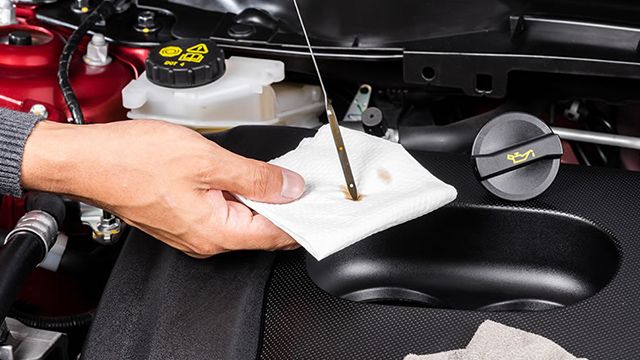A car that is more than a few years old may need some oil in between services. Even some showroom-fresh models have been known to consume a little! Most of the time, there is nothing to be concerned about. Regular engine oil checks are essential to maintaining the health of your engine and maximizing its mileage.
Please read this article thoroughly if you want to learn how to check engine oil.
How To Check The Engine Oil With A Dipstick?
Prepare To Check
Make sure your car is level, have the parking brake engaged, the transmission in Park (or a lower gear if it’s a manual transmission), and the engine turned off. If you don’t know how to do this, check your owner’s manual.
Most cars have a hood release lever under the left instrument panel. Additionally, before you can raise the hood, you must unlock a safety catch under the front edge of the hood.
Locate The Dipstick

The dipstick is usually easy to identify because it has a small colored handle that is typically yellow or orange and is inscribed with an oil-can symbol.
Pull The Dipstick
The dipstick’s housing tube should be fully removed. It resembles taking a sword out of its sheath. Prepare a rag or paper towel and wipe any oil from the dipstick’s tip. One quart less oil is indicated by the lower of the two lines at the dipstick’s tip. The top line indicates that the crankcase, or car’s oil tank, is full. Some dipsticks are also marked with words like “full” and “add.”
Note Oil Level
Push the dipstick all the way down into the tube while slowly inserting it. Now take it out and carefully inspect the tip; it should be covered in oil. Your car has enough oil if the level is between the two lines. It’s time to add a quart if it’s at the low mark or lower.
Wait And Re-check
After adding a quart of oil, wait a few minutes for it to drain into the crankcase before checking the level again to make sure it is at least halfway between the high and low marks. Your engine can run safely even if the oil level is below the high mark.
How Can I Check The Oil Level In My Engine Without A Dipstick?
Some more recent automobiles are built without dipsticks. The oil level is instead read by a sensor (or sensors) inside the engine and shown on the infotainment screen or gauge cluster. This information is frequently tucked away in a submenu and hidden from the driver. To learn precisely how to show the oil level in your car, consult your owner’s manual.
How To Add Engine Oil?
Utilize the owner’s manual’s recommended oil grade. A designation like 0W-20 or 5W-30 is typically attached to it. It is available in quart sizes at all gas stations, auto parts stores, as well as numerous supermarkets and low-cost stores.
Remove the oil filler cap, which is typically found on top of the engine, in order to add oil. To prevent oil from spilling onto the engine, other components, or even the floor, it helps to use a funnel.
You should add oil gradually because overfilling the engine is harmful. Add about a half-quart at first. Spills can be avoided by using a funnel. Check the dipstick again after waiting a few minutes. Add the final quart if the level is still below or close to the minimum mark. You won’t typically need to add more than a quart unless your engine is dripping or burning oil, or if you haven’t checked it in a while. However, if an additional quart is required, add it gradually and check as you go.
Reinstall the oil filler cap tightly.
Conclusions
It will only take a minute or so to check the engine oil level once every few weeks or before a long trip. However, taking this precaution can prevent severe engine damage, which can increase maintenance costs. Now, go and check your engine oil!
Read More: How to Clean Car Engine (Step-by-Step Instructions)



